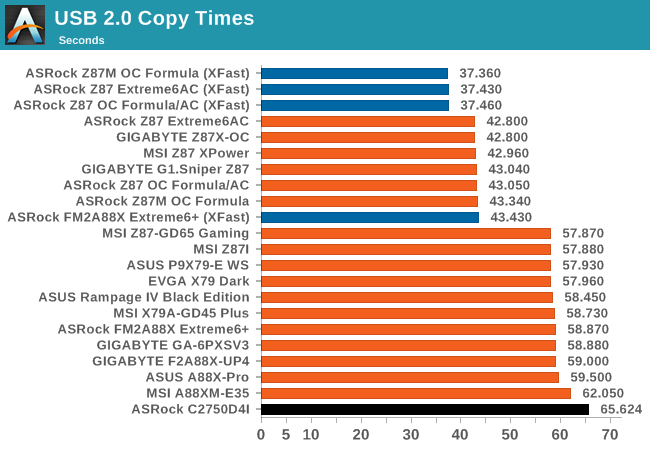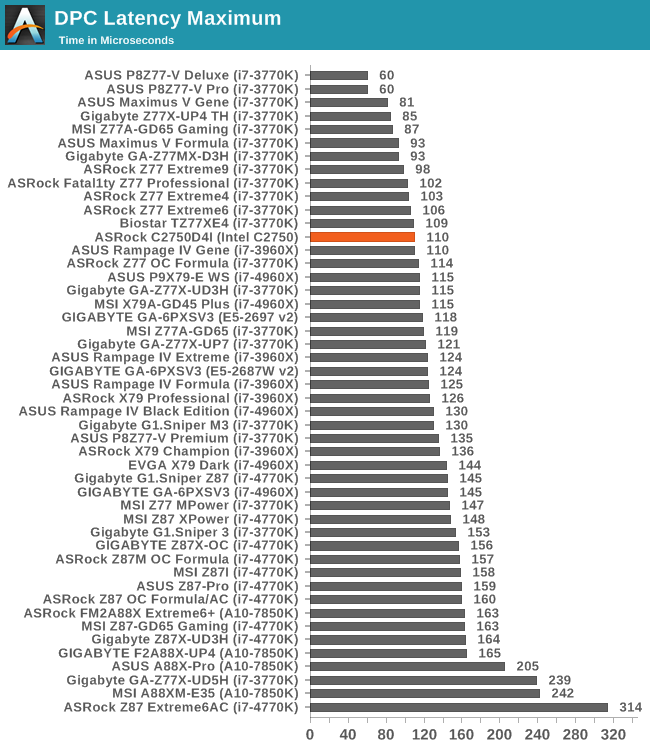ASRock Rack C2750D4I Review: A Storage Motherboard with Management
by Ian Cutress on April 29, 2014 9:00 AM EST- Posted in
- Motherboards
- Storage
- Atom
- ASRock
- Silvermont
- Enterprise
- server
- Avoton
System Benchmarks
USB Backup
For this benchmark, we run CrystalDiskMark to determine the ideal sequential read and write speeds for the USB port using our 240 GB OCZ Vertex3 SSD with a SATA 6 Gbps to USB 3.0 converter. Then we transfer a set size of files from the SSD to the USB drive using DiskBench, which monitors the time taken to transfer. The files transferred are a 1.52 GB set of 2867 files across 320 folders – 95% of these files are small typical website files, and the rest (90% of the size) are the videos used in the WinRAR test. In an update to pre-Z87 testing, we also run MaxCPU to load up one of the threads during the test which improves general performance up to 15% by causing all the internal pathways to run at full speed.

USB effectiveness is often limited by how quickly a system can turn on all the pathways for the required data, as well as the underlying chipset implementation. Avoton is not going to win any records today for USB speed, and the lack of a USB 3.0 port is an oversight.
DPC Latency
Deferred Procedure Call latency is a way in which Windows handles interrupt servicing. In order to wait for a processor to acknowledge the request, the system will queue all interrupt requests by priority. Critical interrupts will be handled as soon as possible, whereas lesser priority requests, such as audio, will be further down the line. So if the audio device requires data, it will have to wait until the request is processed before the buffer is filled. If the device drivers of higher priority components in a system are poorly implemented, this can cause delays in request scheduling and process time, resulting in an empty audio buffer – this leads to characteristic audible pauses, pops and clicks. Having a bigger buffer and correctly implemented system drivers obviously helps in this regard. The DPC latency checker measures how much time is processing DPCs from driver invocation – the lower the value will result in better audio transfer at smaller buffer sizes. Results are measured in microseconds and taken as the peak latency while cycling through a series of short HD videos - less than 500 microseconds usually gets the green light, but the lower the better.

While the system is not a digital audio workstation target, as our DPC test is quick and painless the results are included for completeness. The system actually does rather well, right in the middle of our Z77 testing.










85 Comments
View All Comments
mars2k - Saturday, May 31, 2014 - link
I'm with you Up, how did this get sidetrac'd into HTPC, I'm looking for an alternative to some of the stock Qnap and Synology geer for use in my home. Want NAS box with lots of tru put. Not clear on why Ian says no NAS. Whats up with configuring as a NAS? Any other suggestionssamueldes - Thursday, November 27, 2014 - link
Before you buy: the Areca PCIe X8 card won't fit in the ASUS AM1 board with only one PCIe X4 slot.Ammohunt - Wednesday, April 30, 2014 - link
Avoton supports intels visualization extensions with 64GB of RAM and 8 cores it could be a decent low powered KVM server sliced up in many different ways.stoatwblr - Wednesday, April 30, 2014 - link
I have to say I'm surprised they didn't go with minisas connectors instead of a fistful of satas. Supermicro have done the same thing and it simply doesn't make sense.Samus - Friday, May 2, 2014 - link
yeah they could have saved a ton of real estate using mini plugs. Even full sized servers like HP's ML310 series use mini plugs to keep the board clean. Even more important on an ITX board. This board has a lot of oversights, which ASRock will learn is unacceptable in the market they're targeting it at.ericloewe - Friday, May 2, 2014 - link
Bad idea in this case, since they're using SATA instead of SAS. Someone would inevitably try to use this with an SAS expander...But I agree with Supermicro having made an odd choice. Their LSI2308-equipped motherboards would be perfectly equipped with SAS connectors.
speculatrix - Sunday, May 4, 2014 - link
if you're looking more for a media player you can plug into your TV, then one of the many other Baytrail-D motherboards would be suitable... there's a useful list and discussion of them here:http://www.silentpcreview.com/forums/viewtopic.php...
bernstein - Tuesday, April 29, 2014 - link
i'm probably one of the core target prosumers for this, as for a few years now i've been running something similar at home...namely a sandybridge itx board, 35 Watt i3, ecc ram, supermicro low profile (lsi) sas controller, supermicro 24x (lsi) sas expander backplane, 400w passive psu, passive cpu cooler, 18 sata 2.5" hdds (5200rpm - WD scorpio blue / hitachi travelstar)
and while this board fits my requirements wonderfully while being cheap there is just one dealbreaker... 12x sata? wtf? no-one sane will run so many hdds without a backplane. it's just unmanageable.
the most simple backplane with 12 sata plugs + some power plugs & 12 correctly spaced hdd plugs woud do. and could be manufactured & sold very cheaply. but there is no such thing... (step up asrock :)
bernstein - Tuesday, April 29, 2014 - link
to the point: give me such a backplane for below $100 and im sold. else thanks but no thanks.ZeDestructor - Tuesday, April 29, 2014 - link
With 18 drives, you might want to consider a BackBlaze pod with room for 45 drives, especially now that we have 32 and 40 disk controllers. That with some ZFS would be quite an excellent NAS IMO, and I am heading that way, slowly.